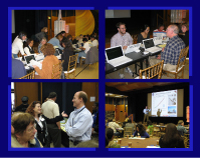When the University of Southern California (USC) and the University of California, Los Angeles (UCLA) announced their collaboration on a project called
COSEE-West, it was only a matter of time before bets were placed on how long a partnership could last between such storied rivals. Six years later, COSEE-West has become a tremendous force for ocean sciences education in our many surrounding communities. We have created a unique arsenal of standard and innovative approaches that link faculty from 13 universities and research institutions, educators from at least 8 informal science education centers, and over 350 teachers from 30 school districts, including the second largest school district in the nation, the Los Angeles Unified School District (LAUSD).
Los Angeles is often characterized as an endless paradise where the surf is always up and a beach is never far away. In reality, it is a thriving metropolis that is infamous for its traffic and congestion. Our beaches attract 100 million residents and tourists every year, yet half of the 2.6 million students in schools across the LA basin have never burned their toes in the hot sand of a sunny beach. Part of the problem is due to our sprawling geography, part of the problem lies with the very urban nature of Los Angeles, and part of the problem is that the educators surrounding these students have no experience with the ocean themselves.
Such ignorance about the largest ecosystem on the planet, and one right on our doorstep no less, was and continues to be a serious issue that needs to be addressed. Although ocean science education programs existed in Los Angeles prior to the inception of COSEE-West, their reach was often limited. COSEE-West strove to create links between all these communities of learners by becoming a hub that people could access in order to learn from or to pass information on to those who need it.
COSEE-West's first five years emphasized the role of research scientists in education, combining their expertise with the classroom know-how of K-12 teachers and informal science educators to create scientifically current, teachable products that could educate a wide-ranging audience. One of the challenges of integrating scientists into education and outreach stems from the culture ingrained across academic institutions. Those who are interested in such activities are often left on their own. By working with academics and the College of Exploration to meet NSF Criterion II requirements by presenting NSF- sponsored ocean sciences lectures to general audiences, COSEE-West has made great strides in narrowing the disconnect between K-12 schools and the Universities.
One exciting collaboration involved helping a UCLA faculty member develop a Criterion II ocean observatory education project for his NSF-funded research project. Los Angeles teachers are now creating lesson plans using near real-time data collected by UCLA's Santa Monica Bay Observatoryand other moorings in the Southern California Coastal Ocean Observatory System.
Our next five years will build on our past successes by expanding our reach even further. The Internet has become a very powerful tool through which distance learning is a common way of reaching people across the globe. Our upcoming online workshop, designed and facilitated by the College of Exploration, will utilize both faculty and undergraduate students from UCLA to teach and to learn from the workshop participants. Participating teachers will get to experience the Marine Biology Quarter at the Gump Research Station on Moorea, French Polynesia along with UCLA undergraduates and faculty. Similar online workshops that feature courses in ocean science offered by USC faculty for students at USC are planned for next year.
| |  |
|
A second, very effective way of reaching a greater number and a wider variety of people is through our informal education partners and research institutions. COSEE-West has used the model of our science content lectures and educator sessions to help local informal science education centers craft their own lecture series. The Santa Monica Bay Aquarium is holding their first series of lectures this year. NASA's Jet Propulsion Laboratory (JPL) has made it a point to make their JPL/COSEE-West lectures an annual event. The Cabrillo Marine Aquarium is able to tap into our vast network of formal and informal educators and get their programs and events out to a larger audience than they ever have before.
COSEE-West has also created new programs with funding from private foundations and corporations (the QuikScience Challenge and the Edison Challenge respectively) that stimulate teams of students and their teachers to enhance their curriculum with marine science modules, conduct service-learning projects in their communities and to express their success in creative ways.
The response to the COSEE-West model has been enthusiastic and sustained. People are hungry for engaging, high quality material. When they realize that science is neither the cure for insomnia nor the exclusive purview of brainiacs in a laboratory, they bring that realization and enthusiasm to their students and families. Our efforts were not the first in ocean science education, nor will they be the last, but we are unique. COSEE-West's network brings people together from hundreds - if not thousands - of miles away with the same goal: to bring the wonder and beauty of our blue planet to the people who will ultimately end up caring for it.
Visit COSEE-West!
Contributed by Jane Lee

